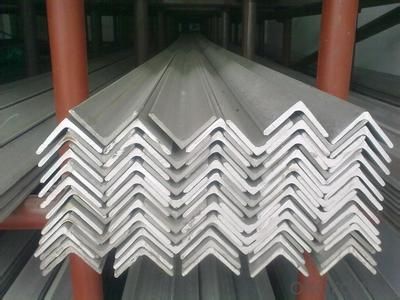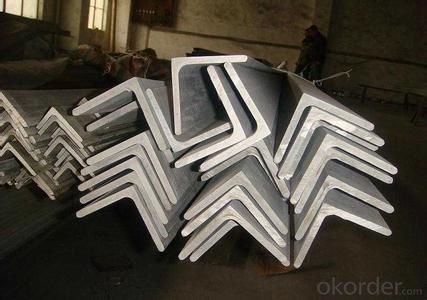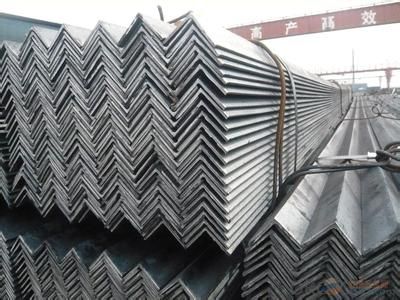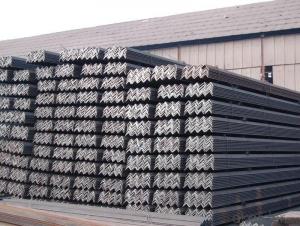Angle Steel Hot Rolled High Quality ASTM Or GB Standard
- Loading Port:
- Tianjin
- Payment Terms:
- TT OR LC
- Min Order Qty:
- 25 m.t.
- Supply Capability:
- 20000000 m.t./month
OKorder Service Pledge
OKorder Financial Service
You Might Also Like
Item specifice
Product Description:
OKorder is offering Angle Steel Hot Rolled High Quality ASTM Or GB Standard at great prices with worldwide shipping. Our supplier is a world-class manufacturer of steel, with our products utilized the world over. OKorder annually supplies products to European, North American and Asian markets. We provide quotations within 24 hours of receiving an inquiry and guarantee competitive prices.
Product Applications:
According to the needs of different structures, Angle can compose to different force support component, and also can be the connections between components. It is widely used in various building structures and engineering structures such as roof beams, bridges, transmission towers, hoisting machinery and transport machinery, ships, industrial furnaces, reaction tower, container frame and warehouse etc
Product Advantages:
OKorder's SteelAngle Steel Hot Rolled High Quality ASTM Or GB Standard are durable, strong, and resist corrosion.
Main Product Features:
· Premium quality
· Prompt delivery & seaworthy packing (30 days after receiving deposit)
· Corrosion resistance
· Can be recycled and reused
· Mill test certification
· Professional Service
· Competitive pricing
Product Specifications:
Manufacture: Hot rolled
Grade: Q195 – 235
Certificates: ISO, SGS, BV, CIQ
Length: 6m – 12m, as per customer request
Packaging: Export packing, nude packing, bundled
Sizes: 25mm-250mm | ||||||||||||
a*t | ||||||||||||
25*2.5-4.0 | 70*6.0-9.0 | 130*9.0-15 | ||||||||||
30*2.5-6.6 | 75*6.0-9.0 | 140*10-14 | ||||||||||
36*3.0-5.0 | 80*5.0-10 | 150*10-20 | ||||||||||
38*2.3-6.0 | 90*7.0-10 | 160*10-16 | ||||||||||
40*3.0-5.0 | 100*6.0-12 | 175*12-15 | ||||||||||
45*4.0-6.0 | 110*8.0-10 | 180*12-18 | ||||||||||
50*4.0-6.0 | 120*6.0-15 | 200*14-25 | ||||||||||
60*4.0-8.0 | 125*8.0-14 | 250*25 | ||||||||||
FAQ:
Q1: How do we guarantee the quality of our products?
A1: We have established an advanced quality management system which conducts strict quality tests at every step, from raw materials to the final product. At the same time, we provide extensive follow-up service assurances as required.
Q2: How soon can we receive the product after purchase?
A2: Within three days of placing an order, we will begin production. The specific shipping date is dependent upon international and government factors, but is typically 7 to 10 workdays.
Q3: What makes stainless steel stainless?
A3: Stainless steel must contain at least 10.5 % chromium. It is this element that reacts with the oxygen in the air to form a complex chrome-oxide surface layer that is invisible but strong enough to prevent further oxygen from "staining" (rusting) the surface. Higher levels of chromium and the addition of other alloying elements such as nickel and molybdenum enhance this surface layer and improve the corrosion resistance of the stainless material.



- Q:Can steel angles be used as reinforcements in concrete structures?
- Certainly! Reinforcements in concrete structures can include steel angles. Due to their exceptional strength and durability, steel angles are commonly utilized in concrete structures. These angles are placed within the concrete to provide additional support, preventing cracking or failure when subjected to heavy loads or stress. Steel angles offer versatility and are easily incorporated into the designs of various concrete structures, such as beams, columns, walls, and slabs. They are often combined with other reinforcement materials, like steel bars or mesh, to enhance the overall strength and stability of the concrete structure. The preference for steel angles arises from their ease of installation, cost-effectiveness, and ability to withstand the harsh environmental conditions typically encountered in construction projects.
- Q:How do steel angles perform in terms of acoustic insulation?
- Because steel angles are primarily used as structural components, they do not offer considerable acoustic insulation. Although steel is a dense material that can partially block sound waves, the L-shape and open design of steel angles result in inadequate sound absorption and transmission loss. Furthermore, the thinness of steel angles and their lack of specific acoustic properties limit their effectiveness in reducing noise transfer. To achieve optimal acoustic insulation, it is recommended to combine steel angles with other materials like acoustic panels, insulation batts, or soundproofing materials to create a more efficient sound barrier.
- Q:How do steel angles contribute to the overall load distribution in a structure?
- The contribution of steel angles to the overall load distribution in a structure cannot be underestimated. These L-shaped beams, also known as angle irons, play a vital role in construction projects. One of the key advantages of steel angles is their ability to offer stability and support to different parts of a structure. These angles are commonly used as braces, reinforcing the framework and preventing excessive movement or deformation. By evenly distributing the load across various sections of the structure, steel angles ensure the stability and integrity of the building. Furthermore, steel angles are frequently employed as connectors between different structural elements. They can be bolted or welded to beams, columns, or plates, acting as connectors that transfer loads from one component to another. This transfer of loads helps redistribute forces and minimize concentrated stress, thereby improving the load-bearing capacity and overall performance of the structure. Moreover, steel angles find use in the construction of platforms, stairs, and other support structures. By providing a secure and stable platform for people or equipment, they contribute to the overall load distribution by safely distributing the weight and forces applied to these structures. In summary, steel angles are indispensable in ensuring the overall load distribution in a structure. They provide stability, support, and connections between various structural components. The even distribution of weight and stress they enable helps prevent structural failures, ensuring the longevity and safety of the building.
- Q:What are the common industry standards for steel angles?
- The American Society for Testing and Materials (ASTM) primarily determines the common industry standards for steel angles. ASTM A36, widely recognized as a standard for structural steel angles, finds common usage in construction and industrial applications. This standard specifies the chemical composition, mechanical properties, and other relevant characteristics of the steel angles. Another commonly used standard, ASTM A572, is specifically designed for high-strength low-alloy (HSLA) steel angles. It provides guidelines for the chemical composition, mechanical properties, and notch toughness of the angles. Additionally, several other ASTM standards, including A529, A588, and A992, dictate the requirements for specific types of steel angles used in different applications. By ensuring that steel angles meet the necessary quality and performance criteria, these standards enable consistent and reliable use across various industries.
- Q:How do you store steel angles to prevent damage?
- To prevent damage and maintain the integrity of steel angles, it is crucial to adhere to certain best practices. Firstly, one must ensure that the storage area remains clean, devoid of any moisture or humidity. The presence of moisture can lead to corrosion and rusting, which can progressively harm the angles. It is highly recommended to store steel angles indoors, in a well-ventilated space, away from direct sunlight and extreme temperature changes. This precautionary measure aids in minimizing the risk of potential damage caused by exposure to natural elements. When stacking steel angles, it is of utmost importance to employ appropriate supports or racks to prevent them from bending or warping under their own weight. Avoiding excessive stacking height is essential, as it can lead to instability and potential accidents. Incorporating pallets or other suitable storage systems can effectively preserve the angles' integrity and reduce the likelihood of damage. Furthermore, it is advisable to separate steel angles of different sizes and types to prevent scratching, chipping, or any other physical damage. Placing protective materials, such as plastic or rubber mats, between layers or individual angles can provide an additional layer of safeguarding. Regular inspections of the storage area play a critical role in identifying any signs of early damage, such as rust spots or deformation. In the event of any issues, addressing them promptly is vital to prevent further deterioration and ensure the quality of the steel angles.
- Q:What are the properties of steel angles?
- Steel angles have several properties that make them highly versatile and widely used in various industries. Firstly, they have excellent strength-to-weight ratio, providing structural stability and support. Secondly, steel angles offer great resistance to corrosion and impact, ensuring durability in different environments. Additionally, they have high malleability and ductility, allowing for easy fabrication and shaping to meet specific design requirements. Lastly, steel angles possess good thermal conductivity and are fire-resistant, making them suitable for applications where heat transfer and fire protection are crucial.
- Q:How do you calculate the second moment of area for a steel angle?
- To calculate the second moment of area for a steel angle, you need to follow a step-by-step process. Here's how you can do it: 1. Begin by drawing the cross-section of the steel angle on a piece of paper or using a CAD software. Make sure to label all the dimensions accurately. 2. Divide the angle into smaller geometric shapes, such as rectangles and triangles, which are easier to calculate the second moment of area for. 3. Calculate the individual second moments of area for each geometric shape. The formula for the second moment of area, also known as the moment of inertia, varies depending on the shape. For rectangles, the formula is (b * h^3) / 12, where b is the base and h is the height. For triangles, the formula is (b * h^3) / 36, where b is the base and h is the height. Adjust the formulas based on the orientation and position of the shapes within the angle. 4. Sum up the individual second moments of area for all the shapes within the angle. If there are any holes or cutouts in the angle, subtract their second moments of area from the total. 5. Once you have calculated the second moments of area for all the shapes and accounted for any cutouts, add them up to obtain the total second moment of area for the steel angle. It's important to note that the second moment of area represents the resistance of a cross-section to bending. It is a crucial parameter in structural analysis and design, as it helps determine the strength and stability of a member under loads.
- Q:Are steel angles affected by creep?
- Yes, steel angles are indeed affected by creep. Creep is a phenomenon where materials, including steel, deform over time under a constant load or stress. Steel angles, being structural components, are subjected to various loads and stresses, especially if they are part of long-term applications such as bridges or buildings. Over time, the sustained stress can cause the steel angles to gradually deform, leading to creep. Therefore, it is essential to consider creep effects when designing structures that incorporate steel angles to ensure long-term structural integrity.
- Q:Are steel angles cost-effective?
- Indeed, steel angles prove to be economical. Their versatility and durability lead to their extensive use across different industries and construction endeavors. The simplicity of their manufacturing process, along with their widespread availability and impressive strength-to-weight ratios, contribute to their high cost-effectiveness. Furthermore, the extended lifespan of steel angles reduces the necessity for frequent replacements or repairs, ultimately minimizing maintenance expenses in the long term. Additionally, the recyclability of steel angles aligns with environmental consciousness and sustainability. All in all, the affordability of steel angles establishes them as a favored option for both structural and architectural purposes.
- Q:How are steel angles made?
- Steel angles are made through a process called hot rolling, where steel billets are heated and passed through a series of rollers to give them their desired shape and dimensions.
1. Manufacturer Overview |
|
|---|---|
| Location | |
| Year Established | |
| Annual Output Value | |
| Main Markets | |
| Company Certifications | |
2. Manufacturer Certificates |
|
|---|---|
| a) Certification Name | |
| Range | |
| Reference | |
| Validity Period | |
3. Manufacturer Capability |
|
|---|---|
| a)Trade Capacity | |
| Nearest Port | |
| Export Percentage | |
| No.of Employees in Trade Department | |
| Language Spoken: | |
| b)Factory Information | |
| Factory Size: | |
| No. of Production Lines | |
| Contract Manufacturing | |
| Product Price Range | |
Send your message to us
Angle Steel Hot Rolled High Quality ASTM Or GB Standard
- Loading Port:
- Tianjin
- Payment Terms:
- TT OR LC
- Min Order Qty:
- 25 m.t.
- Supply Capability:
- 20000000 m.t./month
OKorder Service Pledge
OKorder Financial Service
Similar products
New products
Hot products
Related keywords


























